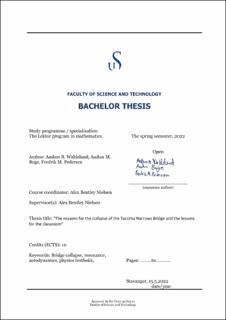| dc.contributor.advisor | Nielsen, Alex B. | |
| dc.contributor.author | Boge, Audun M. | |
| dc.contributor.author | Pedersen, Fredrik M. | |
| dc.contributor.author | Waldeland. Anders B. | |
| dc.date.accessioned | 2022-07-09T15:51:33Z | |
| dc.date.available | 2022-07-09T15:51:33Z | |
| dc.date.issued | 2022 | |
| dc.identifier | no.uis:inspera:93769263:49039990 | |
| dc.identifier.uri | https://hdl.handle.net/11250/3004301 | |
| dc.description.abstract | On 7 November 1940, a historical event occurred for suspension bridge construction and aerodynamic engineering around suspension bridges. Engineers investigating the event concluded the bridge collapsed due to high winds but did not explain how. Later lab tests by other engineers and scientists demonstrated that the collapse happened either due to forced oscillations with Resonance or aeroelastic flutter. Forced oscillations with Resonance treated the bridge as an object being periodically pushed by the winds in Resonance with its natural frequency. And aeroelastic flutter treats the bridge as a wingspan in a fluid stream where the winds would alternate the pushing of the bridge span as it enters above and under the plate. Due to historical similarities, some believed the collapse occurred due to Resonance. However, later articles would discuss the aeroelastic flutter and criticize the resonance argument. One of these articles would be written by Billah and Scanlan, criticizing the use of the bridge as an example of Resonance in physics books and showing an alternative interpretation of the collapse. After discussing the collapse with an expert in aerodynamics on bridges from the University of Stavanger, we were informed that the Billah and Scanlan article is considered the modern explanation by the professional community. However, there are still physics books today that still misrepresent the circumstances around the collapse. We, as teaching students, agree with the Billah and Scanlan article and the opinion of the professional community that the collapse was most likely due to aeroelastic flutter. And that the collapse being represented as Resonance simplifies and misrepresents a more complicated and comprehensive problem around the Tacoma Narrows Bridge. | |
| dc.description.abstract | On 7 November 1940, a historical event occurred for suspension bridge construction and aerodynamic engineering around suspension bridges. Engineers investigating the event concluded the bridge collapsed due to high winds but did not explain how. Later lab tests by other engineers and scientists demonstrated that the collapse happened either due to forced oscillations with Resonance or aeroelastic flutter. Forced oscillations with Resonance treated the bridge as an object being periodically pushed by the winds in Resonance with its natural frequency. And aeroelastic flutter treats the bridge as a wingspan in a fluid stream where the winds would alternate the pushing of the bridge span as it enters above and under the plate. Due to historical similarities, some believed the collapse occurred due to Resonance. However, later articles would discuss the aeroelastic flutter and criticize the resonance argument. One of these articles would be written by Billah and Scanlan, criticizing the use of the bridge as an example of Resonance in physics books and showing an alternative interpretation of the collapse. After discussing the collapse with an expert in aerodynamics on bridges from the University of Stavanger, we were informed that the Billah and Scanlan article is considered the modern explanation by the professional community. However, there are still physics books today that still misrepresent the circumstances around the collapse. We, as teaching students, agree with the Billah and Scanlan article and the opinion of the professional community that the collapse was most likely due to aeroelastic flutter. And that the collapse being represented as Resonance simplifies and misrepresents a more complicated and comprehensive problem around the Tacoma Narrows Bridge. | |
| dc.language | eng | |
| dc.publisher | uis | |
| dc.title | The reasons for the collapse of the Tacoma Narrows Bridge and the lessons for the classroom | |
| dc.type | Bachelor thesis | |
